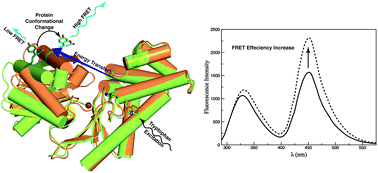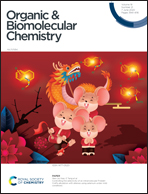An intrinsic FRET sensor of protein–ligand interactions†
Abstract
We describe an approach for the development of fluorescent sensors of metabolite binding in which a genetically encoded fluorescent non-canonical amino acid (fNCAA) containing a 7-hydroxycoumarin moiety (7-HCAA) forms a FRET pair with native tryptophan residues. Although previous studies demonstrated the potential for using 7-HCAA as an acceptor for tryptophan, this approach has not yet been explored within a single protein containing multiple tryptophan residues. A structure-based analysis of a hexokinase enzyme with multiple native tryptophan residues identified glutamate 50 as a potential site of 7-HCAA incorporation; Glu50 moves closer to the native tryptophans upon substrate binding. Substitution of 7-HCAA at residue 50 led to an increase in FRET efficiency in the presence of the substrate; this effect was not observed in a control protein where no change in distance between 7-HCAA and the native tryptophans occurs on substrate binding. This system was then used to directly observe differences in binding affinity of the hexokinase that occur at a number of pH values. Our approach builds on previous research in that it eliminates the need for the incorporation of multiple fNCAAs or fluorescent labels within a target protein and can be used to study substrate binding with native ligands. As such, it serves to expand the versatility of FRET-based techniques.

- This article is part of the themed collection: Chemical Biology in OBC


 Please wait while we load your content...
Please wait while we load your content...